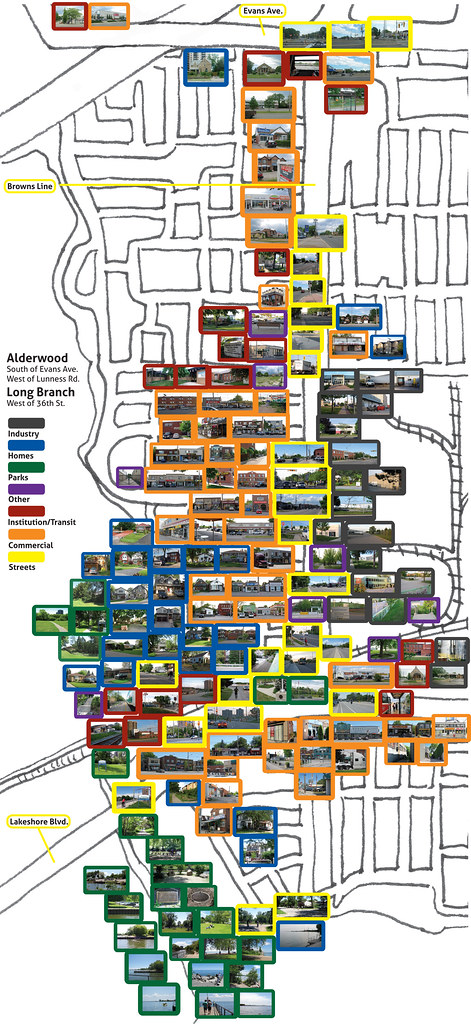
This is part of a series of posts by students in OCAD’s Cities for People summer workshop (click the link to read a bit about what the class was about). This post was researched, photographed and written by Mary-Ellen Simko. More information on the psychogeographic map above at the end of the article.
– – – – – – – – – – – – – – – – – – – – – – – – – – – – – – – – – – – – – – – – – – –
History of the Area
Both Alderwood and Long Branch, adjacent neighbourhoods in the southwest corner of Etobicoke, were a part of Colonel Samuel Smith’s land and many of the streets in Alderwood are named after the farmers in the area. The Alderwood name became official in 1933 and was derived from the First nations word “Etobicoke,” meaning “the place were the alders grow.” Long Branch was named after a resort in New Jersey and ferry boats brought thousands of Toronto vacationers each summer to use the cottages, hotels, the boardwalk and amusement rides including a Coney Island Carousel. It became a more accessible community in 1916 when Lake Shore Boulevard was paved and turned Long Branch into a year-round community.
Stats for Ward 6
Alderwood and Long Branch are home to 56,620 people that comprise 26,240 households located in an area approximately 18 square kilometres in size. In 2006 56% of the occupied private dwellings (31% were single-detached houses) were owned while 44% were rented spaces. 72% of these south Etobicoke residents drive to their jobs while 79% took non-work related trips by car. Most of the new immigration to the area has been from Eastern Europe (primarily Poland) with the highest percentage arriving between 1991 – 2000. Ward 6 has an average household income of 69,500 which is lower than the city of Toronto however 20% report having an income over 100,000. The population demographic has increased between the ages 45-64 but decreased for the age group 5-9 however 60% of households have children. (more info here – pdf)
Transit and how to get there
Both communities are serviced by the Lakeshore east/west Go transit line that stops at Long Branch Go Station while north/south Browns Line has an off-ramp from the QEW and 427 highways. TTC tracks have existed along this southern edge of the city since 1912 and the all-night 501 Streetcar connects the western Long Branch loop to the eastern edge of Toronto at the Neville Park loop. Bus routes on Browns Line and Kipling join the neighbourhoods with the Kipling Subway station.

Where people live
Alderwood is comprised mainly of bungalows and storey-and-a-half houses built after WW2, however during 2001 – 2006 the rate of new construction was 9.1%, the highest since the 1960’s. Most older homes are only separated by a single-car driveway but have large front and backyards so adding a floor or extending backwards are popular methods for increasing square footage. All too often those large front lawns are reduced to allow for more paved driveway as homeowners become multiple car households.
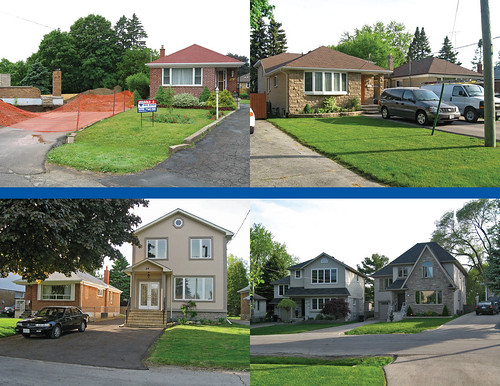
Where people live 2
Years ago any new homes resembled most suburban neighbourhoods with the prominent double-garage, front porch and red brick. In the last ten years builders are offering more options for buyers and replacing houses on prime ravine lots for homes on a much larger scale. In Long Branch, Lake Promenade has million dollar lake front homes not far away from lower income housing.
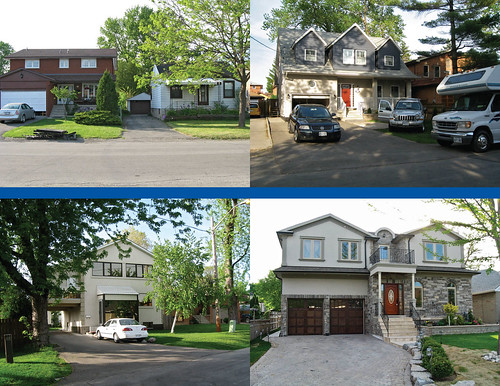
Commercial strip
The rapid physical changes on the residential side streets off Browns Line and Lake Shore Blvd. are very similar however maintaining the commercial businesses on these main arteries remains a struggle. Some reasons for this include high rents, a low population density, unreliable transit and many people opting to drive to malls or big box stores rather than shop local. Recently Burrito Boyz and the Freshwood Grill (both have locations elsewhere in the city) opened their doors on Lake Shore Blvd., offering some casual food options for the south Etobicoke folks.
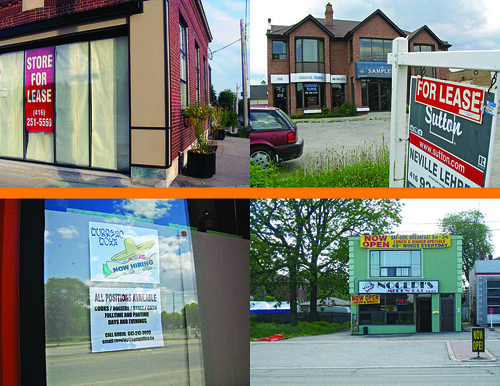
Institutions
The Alderwood Centre was completed in 1999 and includes the new library, public school and child care centre built around the renovated pool. Other changes in Alderwood include the closing of Alderwood Collegiate (Father John Redmond used the site until the new school at Kipling and Lake Shore was built), closing Franklin Horner middle school (which has become a community centre) and using the old library building as a seniors centre.
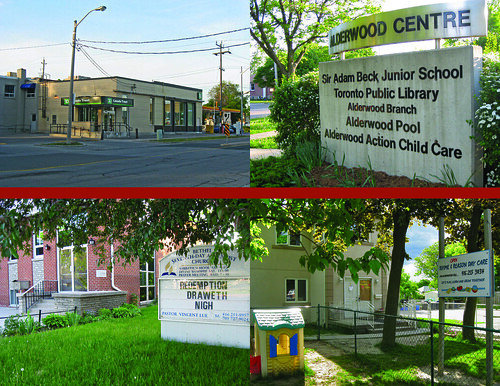
Industry & Nature
Alderwood and Long Branch are separated by an area of light industry and some manufacturing. The city has planted trees, added crosswalk islands and a new public space on the south side of the Browns Line bridge facing Lake Shore Blvd. Both neighbourhoods have nature reserves close by: the Etobicoke Creek ravine and Valley Parks run along the western border and Marie Curtis Park and Lake Ontario are located to the south.
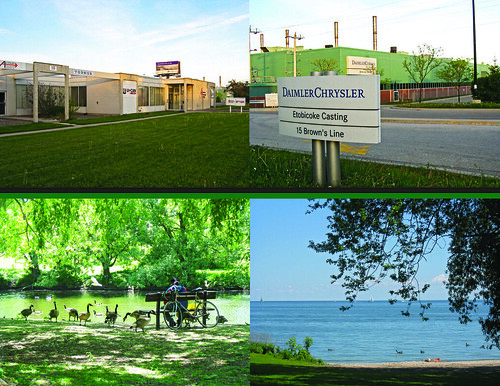
People and some things they do
The Waterfront Trail extends along Lake Promenade and bike lanes are painted on Lake Shore Blvd. encouraging residents and outsiders to ride or rollerblade through the neighbourhoods.
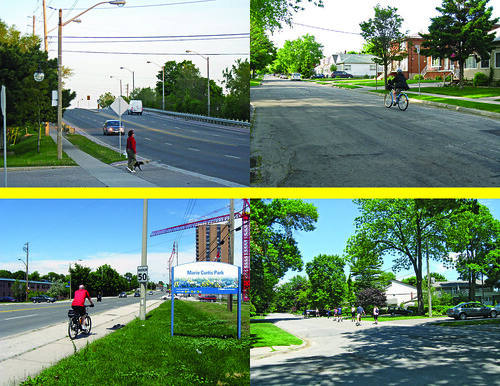
Other transitions of change
While condos are erected on the site of an old burger place, the legion has been a part of the Long Branch community since 1927. This mixing of old and new buildings is prevalent throughout Toronto and is slowly advancing into the outer suburbs. As manufacturing has been replaced by housing further east along the Lake Shore in New Toronto and a No Frills occupies the old Pittsburgh Paints space, it is difficult not to imagine a rezoning of the industrial lands.
Some residents I spoke to felt it was important to bring outsiders into the area as there isn’t enough capital to sustain a viable commercial strip along either Lake Shore Blvd. or Browns Line. Others question the fact that there is only one grocery store in the area and therefore a lack of competition or choice. Although Marie Curtis Park is enjoyed by many people some residents felt it was an underutilized public space. There is frustration around the TTC services available in this southwestern part of the city; there has been some discussion regarding the LRT along Lake Shore Blvd. however the street isn’t wide enough farther east and it would require the removal of a lot of commercial property to accommodate the necessary infrastructure. Providing an extension from Kipling station either west to Sherway Gardens or south to the Humber College site would be beneficial but highly unlikely.
Long Branch has a BIA and a few other groups such as the Lakeshore Planning Council and “Its our Lakeshore” that are involved in various issues concerning the area. Alderwood does not have a BIA and is currently forming a group called the South Alderwood Residents Association or SARA. These community associations are a vital component as southern Etobicoke continues to grow over the next couple of years.
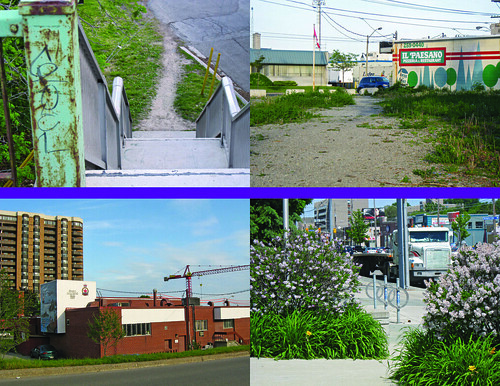
Visual Identity Map for west Alderwood & west Long Branch
These digital images were taken on four trips to the area between May & June 2009. They illustrate what exists within the boundaries of the streets however they are not an exact representation of what that particular street looks like.
Click on map to see larger version.





27 comments
When the city finishes chasing all the good jobs out of the city, via its high commercial/industrial property taxes, areas such as these will resemble what most urbanites resent the most. Car dependant, sleepy bedroom communities with a handful of ‘power centers’.
Long Branch is a great place to live, though the big box stores near Sherway are killing the stores on Lakeshore.
To Glen – if you read the papers, you’ll realize that the recession’s killed alot of companies in the area, like the Chrysler casting plant at Brown’s Line, not city taxes.
The TTC really needs to improve the 501 Queen/Long Branch car reliability. Hopefully the split of the 501 route will help, though this is an overlap downtown, not the return the 507 Lakeshore car that we locals wanted.
Glen> When I wrote an article about the area a few years ago, everybody pointed to the recession of the early 1990s and the Free Trade agreement that sucked much of the industry out of the area.
Shawn, I am familiar with those arguments. They have been repeated ad nauseum. In reality though, from 1995 onwards, while the rest of the region rebounded, areas such as this did not. They continued losing jobs and industry. The same applies to the area where I was raised, Keel/Finch. The industrial areas slowly deteriorated and became vacated, now most of them are occupied by used car dealers. While this was happening there was tremendous growth in new industrial areas in Vaughan, Mississauga, etc.
So while the initial impact of NAFATA played a role in these areas, it did so everywhere. The absence of any rebound is entirely a Toronto phenomenon.
It’s nice that the pictures include some of the older pedestrian stairs, used and unused, of the Brown’s Line railway overpass. I suspect that the overpass was lower and less freeway-ramp-like in the past, but have been unable to find any pictures in the Toronto Archives.
What wasn’t included was some of the sidewalk date stamps from the 1920s that can be found both in Long Branch and the south end of Alderwood. But ya gotta be looking down to notice them.
Glen> So the people who live in the neighbourhood are mistaken? You know better? You ought to go there, and tell them that what they know is wrong. Also, go to Windsor, tell them there was a complete rebound from NAFATA. I have a bunch of relatives and family friends who’d like to hear the news, cuz they probably missed it.
As far as I know, there was no overpass before the present confuguration at the foot of Browns Line came about in the late 50s. (Trivia: that tall light finishing the southward vista is salvage from one of the Eaton Centre makeovers.)
Yes Shawn, they are mistaken if they believe that NAFATA was the the reason that job losses persisted.
Have a look at page 12 here….
http://www.toronto.ca/legdocs/2005/agendas/council/cc051026/pofedp2rpt/cl001.pdf
PS. Last time I checked Windsor was not part of the GTA. It also did not have the breadth of industries that the GTA had. Windsor’s situation is more closely aligned with Detroit’s. I was looking forward to the next issue, but if your remarks are any indication of the depth of research to be expected, perhaps I will pass.
You might also be interested in that between 1989 and 2004 Ward 6 lost 16.6% of its full and part time jobs. Also, between 1991 and 2001 the number of residents in ward 6 whom traveled outside the city to work increased by more than 30%.
At least we can confirm that they didn’t travel to Windsor for work.
Great series.
Glen, I am familiar with your arguments. They have been repeated ad nauseum.
It would be hard to blame property taxes for the decline of the North American auto industry, and places like Goodyear, Pittsburgh Paints, Chrysler Casting, etc. These days, US-based companies are quicker to close their Canadian operations, never mind the effects of “free trade”.
I could show also you major plants in 905-land that have closed as well due to NAFTA and cheaper labour elsewhere, or “Buy America” protectionism, like Canac Kitchens in Markham, Magna in Vaughan, the Nortel plant in Brampton (now owned by Rogers), the GM Plants in Oshawa, the idle Ford Truck plant in Oakville (the jobs going to a new plant in Dearborn, MI, a showpiece for the company headquartered in that town).
I could also show declining industrial areas in Mississauga and Brampton from the 1960s and 1970s, abandoned for new warehouses and plants in greenfields. South Bramalea is one example, where a rental tower recently took the place of an abandoned 1960s industrial property. Look at the former AMC plant in Brampton, it is now a power centre, the Kodak plant in Brampton closed and demolished long before the one in Mount Dennis, the Brampton plant is now single-family dwellings.
Ok Glen, I’ll “pass” on all further comments to you after this one.
Obviously Windsor is not in the GTA – but there is much in common with industrial Toronto and W.
But please do go to New Toronto, Long Branch et al and tell them they are wrong & you know better. You may also want to go to Windsor and tell them they are more aligned with Detroit (and go to Detroit too) as both cities are under the illusion the decline of their industries were connected to NAFTA.
I know Glen’s arguments about TO’s high commercial/industrial tax rates don’t exactly make him the most popular commentator on this site. But overall trends do support what he’s saying. The City of Toronto has been bleeding jobs with many companies that formerly operated within its boundaries pulling up stakes and moving elsewhere within the GTA. There is no question that Toronto’s high commercial/industrial tax rates has been a factor in this.
Some of those wishing to shoot down Glen’s arguments point to things like NAFTA and the fact that there have also been instances of plant closures in Missauga, Bramalae and Oshawa, etc. While these observations are certainly true, I don’t understand how those making them think they negate what Glen is saying. Yes, NAFTA and the global economy have resulted in plant closures not just in Toronto but elsewhere in the GTA — but Toronto’s decline has been accelerated in comparison to other parts of the GTA largely because of companies fleeing to other parts of the GTA with more advantageous rates.
I don’t know that the solution is as simple as just lowering commercial/industrial rates in TO…but those who want to pretend that this isn’t a factor in the job losses sustained by the City of Toronto over the past few decades are sticking their heads in the sand.
As for all the comments regarding what the “people in the neighbourhood” know or don’t know about their situation, they may or may not be mistaken in their views. Also, since the author of this piece did not likely go out and get the views of everyone in this neighbourhood, let’s not talk about what the “people in the neighbourhood” think about their situation as if it encompasses a single point of view.
Unfortunately, “Glen” infests every Toronto site with his single-issue rambling, ramming it down our throats, again and again and again on any pretext whatever. I find myself wishing that industrial and commercial taxes were not so high in the city, if only so that employment would rise and he would presumably perhaps get a job.
samg,
thanks for explaining, better than I could, the reasons for my argument.
Bob, sorry to ‘infest’ threads about the issue. IMO, it is the number one issue facing this city. I also find myself in very good and competent company, with the likes of Don Drummond and Blake Henderson.
The effects of this issue are pervasive. The change in commuting patterns alone has negated any ‘green’ initiatives of the city. Ignoring the origin/destination/employment relationship gives rise to projects like Transit City. A very expensive project that might not provided any real benefit. It also has a tremendous effect on the ability of new immigrants to find work. The list goes on and on, but it might not be of interest to you.
PS. Sean and Shawn, I regularly correspond with many economist, including Peter Morici, Ralph Gomory and Peter Navarro. I consider myself reasonably well versed in the area of the effects of Globalisation.
Glen may find himself in good company, but that company would never rant on such a single issue — or reject the real effect of NAFTA on Toronto in the early nineties, refuses to concede to Sean’s many examples, to make his single issue point (again and again and again). That’s why those economists are listened to, and Glen has a blog nobody reads.
I have made arguments and provided statistics. My detractors here have only offered opinion. I did not not reject the effects of NAFATA, just pointed out the absurdity of ignoring the differences in regional effects, which are drastic.
Perhaps I will constrain my Spacing postings to ‘biking and transit good’, ‘walking better’, and ‘cars bad’.
Happy Jack?
My only discouragment with this thread is that is mostly ignores the content of the original post. It does a nice job of examining local issues and amenities. And for someone who rarely goes to Long Branch I found it quite informative.
Glen makes good points about jobs (though I don’t see a single stat in this thread) but stats show trends, not on the ground effects. Sean Marshall makes a better point by pointing out the actual factories and their related industries. Most that moved out of this area — and lots of other areas — have nothing to do with property/biz taxes and have more to do with labour or other market factors.
I think people shouldn’t dismiss Glen’s POV, and I suspect many readers share those sentiments but maybe not with the same vigor as Glen, but Glen et al. must not just hide behind “stats” since they only reveal the crust of the issue, not the meat (sorry for the poor metaphor).
And I’d suggest commenters be a little more pleasant to one another and not so condescending. Most of us are grown-ups so we should write/act like ones.
Not only is the area’s commercial and industrial landscape shifting, its demographic is shifting as well. A lot of those circa-1950 bungalows still house their original owners, now long since retired.
This means that there’s a major population turnover happening right now. While there are families with several generations living in south Etobicoke (generically Mimico, New Toronto, Long Branch, Alderwood), there are also plenty of people moving into the area.
There’s a whole low-level battle between some of the pur laine residents and “newcomers”. Now, I happen to be a newcomer. It seems to me that the area should be attracting the downtown-condo demographic, who are at least willing to consider shopping locally, and are more resistant to tearing down a bungalow and putting up some Vaughan-standard taupe stucco plywood (particleboard, actually) mansionette.
In my view, projects such as the West Waterfront LRT would encourage the sort of demographic shift that would preserve and enhance these underappreciated parts of the city. The pur laine folks seem more to remember the glory days of the 1950s and 1960s; but I’m not sure they, or anyone, has any sensible or feasible plan to bring those days back.
Glen – I’m sure there’s some too-cool-for-school reason you’re misspelling NAFTA, but it’s annoying.
Sorry Mark, I misspell most words for no other reason other thank being very poor at it. NAFTA and NAFATA just escape my spell checker.
Monica,
I have volumes of reports and research that support my assertions. I have frequently posted links to those that are available. But, as you can see by this thread, the hostility towards what I am saying precludes any meaningful dialogue or investigation with many posters and staff.
So Glen posts his usual stuff, which he does everywhere here, and derails this comment thread from the wider neighbourhood, and then gets all uppity when people decide the issue is more complex than Glen wants it to be, or that they don’t want to just focus on his one issue, or maybe are just tired of it. Seems like posters and staff are in fact pretty tolerant of him, rather than “hostile.” I see other blogs that shut derailers like Glen down without warning. Perfect internet-guy formula — people don’t want to wave my flag, they are hostile.
Meaningful dialogue indeed.
The historical centre of Long Branch is actually to the east of this survey, being between 33rd and 35th streets. That’s where the 1880s Long Branch started.
I still have to get my Spacing “Village of Long Branch” button. But what irks me a little is the phrase “Long Branch Village”. Toronto is now full of “Villages”, whether they were originally villages or not. And in Ontario, the proper term is “Village of ….”, not “…. Village” like BIAs like.
Someone travelling east from Long Branch may well wonder where New Toronto went, as all the BIA signs, including quite a large one, say “Lakeshore Village”. (There’s that damn village thing again.)
When someone asks me where I live, I say “Long Branch”. This almost invariable brings a puzzled frown to their faces. I say, “That’s where all those ‘501 LONG BRANCH’ streetcars run [on a good day].” Oddly, while this does not clear up their puzzlement, it seems to satisfy their questioning and they quickly move on. I don’t know why.
Seems like the bickering is killing an otherwise thoughtful and informative thread. While NAFTA has impacted many areas throughout the continent Toronto under the current leadership has dug a deep hole. Taxation has driven many residents and businesses from the area only to flourish elsewhere. The hostility toward such an obvious and most informed opinion demonstrates a lack of telerence and research. Asking the mostly uninformed residents what they think is absurd. It may be most worthwhile to skip the judgemet and stay with the known facts of common interest. Having a single most informed cuase is not to be treated lightly or to be made fun of. Globalization may be changing the world but without a doubt taxes are killing the GTA. As for those idiotic quint village designators … PLEASE Mimico, Long Brach, New Toronto etc… etc.. need no added identifiers.
Jim – how can residents that have lived in the area for forty years be considered uniformed?
I think complaining about spelling on this forum is really petty and childish.
Grow up.
Does anybody have photos from the 1930-1950s showing the portion of Lake Promenade that is now in Marie Curtis Park i.e west of the pumping station and 42nd St.?